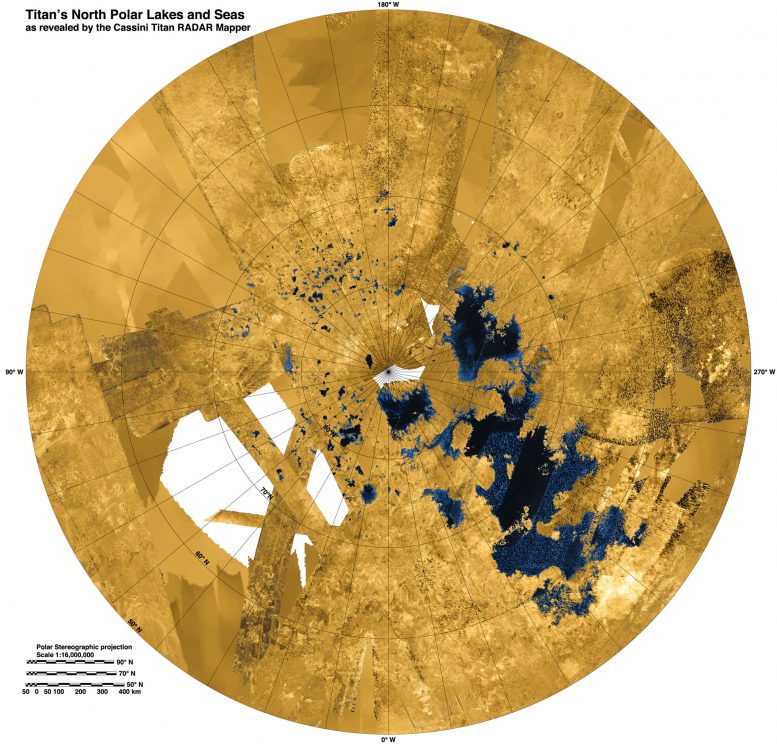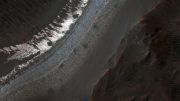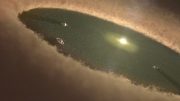New data from NASA’s Cassini spacecraft has helped scientists better understand how Titan’s liquids, solids and gases interact, revealing clues about Saturn’s Earth-like moon.
This colorized movie from NASA’s Cassini mission takes viewers over the largest seas and lakes on Saturn’s moon Titan. The movie is made from radar data received during multiple flyovers of Titan from 2004 to 2013.
NASA’s Cassini spacecraft is providing scientists with key clues about Saturn’s moon Titan, and in particular, its hydrocarbon lakes and seas.
Titan is one of the most Earth-like places in the solar system, and the only place other than our planet that has stable liquid on its surface.
Cassini’s recent close flybys are bringing into sharper focus a region in Titan’s northern hemisphere that sparkles with almost all of the moon’s seas and lakes. Scientists working with the spacecraft’s radar instrument have put together the most detailed multi-image mosaic of that region to date. The image includes all the seas and most of the major lakes. Some of the flybys tracked over areas that previously were seen at a different angle, so researchers have been able to create a flyover of the area around Titan’s largest and second largest seas, known as Kraken Mare and Ligeia Mare, respectively, and some of the nearby lakes.
“Learning about surface features like lakes and seas helps us to understand how Titan’s liquids, solids, and gases interact to make it so Earth-like,” said Steve Wall, acting radar team lead at NASA’s Jet Propulsion Laboratory in Pasadena, California. “While these two worlds aren’t exactly the same, it shows us more and more Earth-like processes as we get new views.”

This colorized mosaic from NASA’s Cassini mission shows the most complete view yet of Titan’s northern land of lakes and seas. Saturn’s moon Titan is the only world in our solar system other than Earth that has stable liquid on its surface. Credit: NASA/JPL-Caltech/ASI/USGS
These new images show Kraken Mare is more extensive and complex than previously thought. They also show nearly all of the lakes on Titan fall into an area covering about 600 miles by 1,100 miles (900 kilometers by 1,800 kilometers). Only 3 percent of the liquid at Titan falls outside of this area.
“Scientists have been wondering why Titan’s lakes are where they are. These images show us that the bedrock and geology must be creating a particularly inviting environment for lakes in this box,” said Randolph Kirk, a Cassini radar team member at the U.S. Geological Survey in Flagstaff, Arizona. “We think it may be something like the formation of the prehistoric lake called Lake Lahontan near Lake Tahoe in Nevada and California, where deformation of the crust created fissures that could be filled up with liquid.”
A creative application of a method previously used to analyze data at Mars also revealed that Ligeia Mare is about 560 feet (170 meters) deep. This is the first time scientists have been able to plumb the bottom of a lake or sea on Titan. This was possible partly because the liquid turned out to be very pure, allowing the radar signal to pass through it easily. The liquid surface may be as smooth as the paint on our cars, and it is very clear to radar eyes.
The new results indicate the liquid is mostly methane, somewhat similar to a liquid form of natural gas on Earth.
“Ligeia Mare turned out to be just the right depth for radar to detect a signal back from the sea floor, which is a signal we didn’t think we’d be able to get,” said Marco Mastrogiuseppe, a Cassini radar team associate at Sapienza University of Rome. “The measurement we made shows Ligeia to be deeper in at least one place than the average depth of Lake Michigan.”
One implication is that Cassini scientists now can estimate the total volume of the liquids on Titan. Based on Mastrogiuseppe’s work, calculations made by Alexander Hayes, of Cornell University in Ithaca, New York, show there are about 2,000 cubic miles (9,000 cubic kilometers) of liquid hydrocarbon, about 40 times more than in all the proven oil reservoirs on Earth.
As Cassini gets closer to northern summer in the Saturn system, mission scientists look forward to potentially the most exciting time for weather at Titan’s northern hemisphere.
The Cassini-Huygens mission is a cooperative project of NASA, the European Space Agency, and the Italian Space Agency. JPL, a division of the California Institute of Technology in Pasadena, manages the mission for NASA’s Science Mission Directorate in Washington. JPL designed, developed, and assembled the Cassini orbiter. JPL and the Italian Space Agency, working with team members from the US and several European countries, built the radar instrument.









Thank you for including clear subtitles with your video clip titled “Cassini Reveals Clues about Saturn’s Moon Titan.” I am hearing impaired and can’t understand spoken speech unless it’s face-on. But this presentation was fabulous; it’s a very good way to bring fascinating science topics to everyone, even those people learning English!